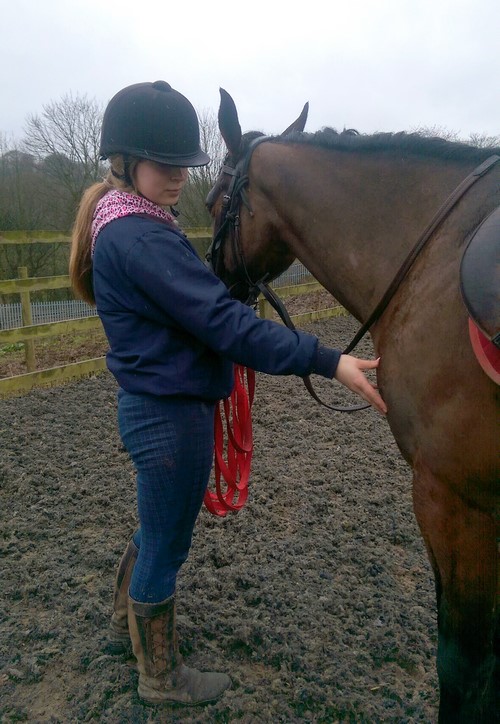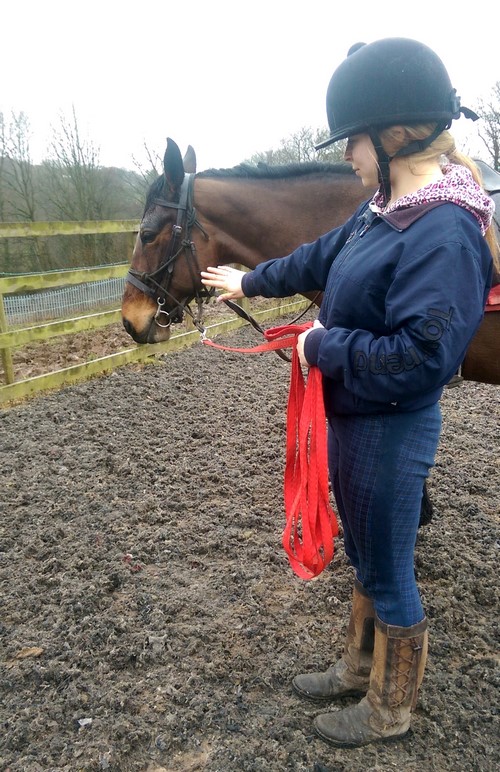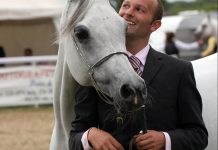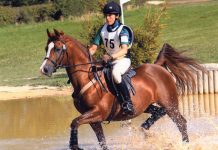Welcome back to our Enhanced Riding series of articles, and at this point in our journey we will be looking at the much debated topic of starting youngsters. These next few articles are also relevant if you are re-schooling or re-educating an older horse, or one that has behavioural problems. When addressing behavioural problems it is sometimes a good idea to strip things right back to basics and in some cases completely re–back the horse, starting again from point zero.
There is much debate in the horse world about methods of starting youngsters and at what age certain things should be done or not done. The truth is that there are a multitude of methods that work well and, of course, just as many methods that are not so good. If we get it wrong in the early days, and give the horse a bad or scary experience, this can have an adverse affect on the horse’s behaviour that can last a lifetime. If, however, we get it right then we will have a well adjusted, trainable, pleasurable horse to own that is happy to work for us.
We are going to explain how to avoid giving the horse a bad experience and how important understanding basic horse psychology is to successfully starting your youngster. We will discuss several different methods along our journey and emphasise the importance and advantages of starting on the ground first. Humans are individual; we each have different personalities, strengths and weaknesses, we all learn differently and find some things hard while others come easily. Animals are no different and we should remember this when training them. What works for one horse may not necessarily work for another. We must always read the situation and react in a positive way to our horse, trying to understand things from their point of view. After all, we all know that they have one! It is also paramount to remember that the horse’s welfare and wellbeing should be at the forefront of our minds at all times. We need to take leadership in a kind, firm but empathetic way.
How many times have you heard somebody say “My horse is naughty” or overheard them call their horse a derogatory name? We have all been there, I think, but often the so-called ‘naughty’ behaviour has only come about because the horse does not understand the question in front of him. We often misunderstand our horse’s behaviour and mistake it for a human response; he may be attempting to communicate with us or displaying a learned behaviour, a habit.
Let’s look at an example; the bucking horse. Surely, this could be classed as naughty, right? Well, no. The horse may be in pain, have a bad back or an incorrectly fitting saddle. He may be full of energy as he hasn’t been turned out for a few weeks. He may have genuinely spooked and reacted by bucking, as some horses do. Maybe he is backing off and napping, feeling insecure and wanting to go back to the herd where he feels safe. Or perhaps the horse is just young and feels a bit unbalanced and wobbly with the rider up there for his first canter.
When we first start working a youngster, he has no idea what we are trying to achieve. We should give him time to work things out so that he comes to know what is expected of him and that he will be safe. To take a youngster away from his herd and expect him to trust us is a big thing to ask; it goes against all of his natural instincts of safety in numbers. If we take the process slowly, however, and put in place a routine, we can avoid any so-called ‘naughty’ behaviour. The horse does not automatically know or accept what is happening to him. So, it is not until we have got to the bottom of the buck, or whatever behaviour is displayed, that we can come up with a solution.
In truth, the reason is never naughtiness; even if he is exhibiting a learned behaviour, it is the human’s fault for setting up the wrong association. For instance, when a horse first does ‘the bad thing’, so many riders dismount and put the horse back in the stable; he remembers this and learns that every time he does ‘the bad thing’, work time is over. We are trying to prevent and/or minimise behaviour such as bucking and napping from occurring in the first place and we do this by understanding how the horse may feel when he is first brought into work.
Reading the situation is therefore crucial and trying to prevent the behaviour in the first place, by understanding the horse’s physical and mental development and needs, is essential!
 |
| Backing Up |
From ground to saddle – slowly
Before considering getting on we must ensure that our horse has been well handled, is happy and calm walking in hand, grooming, picking up feet, rugs and of course has been introduced to a saddle and bridle. The best way to do this is by tacking your horse up as part of their daily routine. Never make any sudden movements and watch out for his reactions. If he is trying to avoid the bridle or saddle it may be that he doesn’t know what is about to happen so let him sniff at it, and place it gently all over his body. That way, you will very quietly desensitise him to the equipment. Remain calm and reassuring throughout, never forcing or shouting, as that will only make him suspicious.
Some horses are particularly claustrophobic and feel more threatened in their stable; as a flight animal, he may feel anxious in spaces from which he cannot escape should he need to. Essentially, remember that your youngster will assume that everything is potentially going to eat him! The claustrophobic horse may be happier tied up outside the stable. Another option is to pop a pressure halter on and a lunge line, and have an assistant hold him while you do the desensitising. In this way, should he try to get away, you are kept safe and he will gradually learn that he doesn’t need to run away, and that the equipment is safe. Always wear suitable clothing and footwear, a hard hat and gloves. Working in a safe place such as a round pen, arena or fenced off piece of grass is the best policy too, for everybody’s safety.
Once acceptance of tack is achieved its time to start walking around to introduce your horse to the area you are going to work in. It is sensible to fence off your chosen space so there is a clear boundary. This helps both horse and rider be clear and consistent. You could simply use raised poles, bales or tyres if funds are limited. If you have a purpose built all weather arena, that is perfect!
 |
| Blocking |
Walking your horse in hand, fully tacked, will get him used to the feel of his tack as he moves, as well as what you expect from him when he is in work mode. Keeping sessions short at first will help prevent boredom and napping. It will also ensure more focus; just as a young child loses concentration easily, so will your young horse. Placing a pressure halter under your bridle (without reins) gives you greater and clearer control of the horse; you can be effective, without the bit pulling in his mouth. Using a lunge line is good for safety too.
Your horse should stay at arm’s length with you slightly in front of the shoulder, level with his head, and you should be able to lead from both sides. Practice your straight lines at first. You may find that your horse is better at staying out on the left rein (anticlockwise) than he is on the right rein (clockwise), although occasionally a horse is naturally the other way round. This is normal. He will be stiffer on one side just like we are left or right handed. He has spent the first few years of his life out in the field favouring one side. He may need a little extra help staying out on the right rein. If he tries to come in simply push his nose gently away with your hand, making sure you don’t step inwards. If he tries to run ahead and cut in front you should prevent this by keeping slightly ahead, raising your hand to stop, and cutting him off using your body language.
Learning to push your horse backwards is essential in the early days as it reminds him that you are the dominant leader. If he is in control on the ground then you don’t have much hope of taking change once in the saddle. Establishing leadership on the ground first is not only safer, but crucial! How many times has your horse made you step out of the way, even gently, without you noticing? Every time he does this he is actually dominating you. We should all make our horses back up, so correct him, or else his domination may escalate.
To back him up: Stand in front of and facing your horse, slightly to one side. With a little nose pressure, squeezing and releasing, push him backwards while walking forwards towards him.
When should we start riding and how much should we do?
This is a question that is asked frequently and there are differing opinions on the matter with some starting youngsters at two years old and others waiting until four years, at the earliest. To help you make that decision, listed below are some scientific facts about your horse’s physical development that may interest, or influence you:
- The long bones of a horse grow from cartilage by ossification (bone formation) both at the centre (diaphysis) and ends (epiphysis) of the future bone. Situated between these two regions is a (metaphyseal) growth plate that allows the lengthening of the long bones as the foal grows. There is also a second growth plate (epiphyseal) that forms as the ossification at the ends of the bone (epiphysis) advances outward.
- Do you then have to wait until all these growth plates convert to bone, before riding? The answer is no, but the longer you wait, the safer you’ll be. A lot of the bones will be fused by the time the horse is about four years old. So in simple terms, your horse’s bones may be softer and more susceptible to injury prior to fusing, so do we risk riding and trotting / cantering on circles before they are fused?
- Most growth plates lay across the weight bearing plane – knees, ankles, shoulders, for example – and are less affected by the carriage of weight. However, some vertebrae do not fuse until the horse is at least five and a half years old, in some cases older still. You cannot tell the state of their development from their outward appearance. As your horse’s back is the very thing that carries the rider, we therefore have to question when it is too early to ride and what sort of riding we should be doing. For example, is it too early to jump before the back is fused?
- The latest academic research is leaning towards the opinion that breed has no relevance. There is actually no breed that matures later or earlier than the rest, as was first thought. For example, it was once thought that Arabians were late maturing and that thoroughbreds were early. We should really take into consideration our horse’s physical development; after all, we consider our own. Perhaps not asking for too much strenuous work, such as fast and tight circles, before he has developed is the answer; not overdoing the riding before the horse’s back and bones are strong enough. In this way, long term, our horses are going to last longer!
Join us next time when we look at mounting block work. We will also discuss the advantages and disadvantages of lunging, long reining and in hand training, as well as working through some simple in hand schooling exercises useful to introduce your horse to the world of work.












